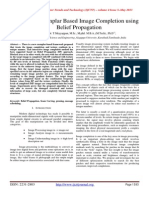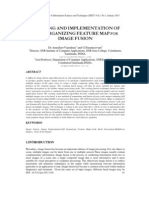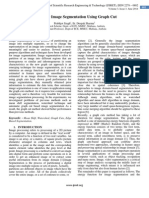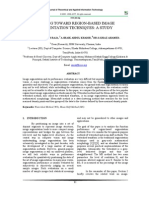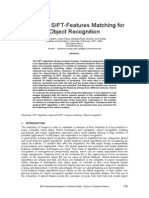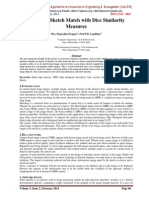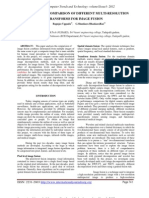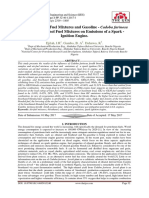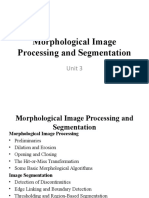0 ratings0% found this document useful (0 votes)
33 viewsBackground Subraction in A Video System Using Morphology Technique
Background Subraction in A Video System Using Morphology Technique
Uploaded by
theijesThe International Journal of Engineering & Science is aimed at providing a platform for researchers, engineers, scientists, or educators to publish their original research results, to exchange new ideas, to disseminate information in innovative designs, engineering experiences and technological skills. It is also the Journal's objective to promote engineering and technology education. All papers submitted to the Journal will be blind peer-reviewed. Only original articles will be published.
The papers for publication in The International Journal of Engineering& Science are selected through rigorous peer reviews to ensure originality, timeliness, relevance, and readability.
Theoretical work submitted to the Journal should be original in its motivation or modeling structure. Empirical analysis should be based on a theoretical framework and should be capable of replication. It is expected that all materials required for replication (including computer programs and data sets) should be available upon request to the authors.
Copyright:
© All Rights Reserved
Available Formats
Download as PDF, TXT or read online from Scribd
Background Subraction in A Video System Using Morphology Technique
Background Subraction in A Video System Using Morphology Technique
Uploaded by
theijes0 ratings0% found this document useful (0 votes)
33 views6 pagesThe International Journal of Engineering & Science is aimed at providing a platform for researchers, engineers, scientists, or educators to publish their original research results, to exchange new ideas, to disseminate information in innovative designs, engineering experiences and technological skills. It is also the Journal's objective to promote engineering and technology education. All papers submitted to the Journal will be blind peer-reviewed. Only original articles will be published.
The papers for publication in The International Journal of Engineering& Science are selected through rigorous peer reviews to ensure originality, timeliness, relevance, and readability.
Theoretical work submitted to the Journal should be original in its motivation or modeling structure. Empirical analysis should be based on a theoretical framework and should be capable of replication. It is expected that all materials required for replication (including computer programs and data sets) should be available upon request to the authors.
Original Title
A 03501001006
Copyright
© © All Rights Reserved
Available Formats
PDF, TXT or read online from Scribd
Share this document
Did you find this document useful?
Is this content inappropriate?
The International Journal of Engineering & Science is aimed at providing a platform for researchers, engineers, scientists, or educators to publish their original research results, to exchange new ideas, to disseminate information in innovative designs, engineering experiences and technological skills. It is also the Journal's objective to promote engineering and technology education. All papers submitted to the Journal will be blind peer-reviewed. Only original articles will be published.
The papers for publication in The International Journal of Engineering& Science are selected through rigorous peer reviews to ensure originality, timeliness, relevance, and readability.
Theoretical work submitted to the Journal should be original in its motivation or modeling structure. Empirical analysis should be based on a theoretical framework and should be capable of replication. It is expected that all materials required for replication (including computer programs and data sets) should be available upon request to the authors.
Copyright:
© All Rights Reserved
Available Formats
Download as PDF, TXT or read online from Scribd
Download as pdf or txt
0 ratings0% found this document useful (0 votes)
33 views6 pagesBackground Subraction in A Video System Using Morphology Technique
Background Subraction in A Video System Using Morphology Technique
Uploaded by
theijesThe International Journal of Engineering & Science is aimed at providing a platform for researchers, engineers, scientists, or educators to publish their original research results, to exchange new ideas, to disseminate information in innovative designs, engineering experiences and technological skills. It is also the Journal's objective to promote engineering and technology education. All papers submitted to the Journal will be blind peer-reviewed. Only original articles will be published.
The papers for publication in The International Journal of Engineering& Science are selected through rigorous peer reviews to ensure originality, timeliness, relevance, and readability.
Theoretical work submitted to the Journal should be original in its motivation or modeling structure. Empirical analysis should be based on a theoretical framework and should be capable of replication. It is expected that all materials required for replication (including computer programs and data sets) should be available upon request to the authors.
Copyright:
© All Rights Reserved
Available Formats
Download as PDF, TXT or read online from Scribd
Download as pdf or txt
You are on page 1of 6
The International Journal Of Engineering And Science (IJES)
|| Volume || 3 || Issue || 5 || Pages || 01-06 || 2014 ||
ISSN (e): 2319 1813 ISSN (p): 2319 1805
www.theijes.com The IJES Page 1
Background Subraction in a Video System Using Morphology
Technique
C.Venkata Subba Reddy. A.Karunakar,
1,
S.S.I.T.S,Rayachoti.
2,
Assistant Professor,S.S.I.T.S,Rayachoti.
------------------------------------------------------ABSTRACT----------------------------------------------------
The capability of extracting moving objects from a video sequence captured using a static camera is a typical
first step in visual surveillance. The idea of background subtraction is to subtract or difference the current
image from a reference background model. This paper proposes a new method to detect moving object based on
background subtraction. First of all, we establish a reliable background updating model based on statistical and
use a dynamic optimization threshold method to obtain a more complete moving object. Here we have written
the core processor Microblaze is designed in VHDL (VHSIC hardware description language), implemented
using XILINX ISE 8.1 Design suite the algorithm is written in system C Language and tested in SPARTAN-3
FPGA kit by interfacing a test circuit with the PC using the RS232 cable. The test results are seen to be
satisfactory. The area taken and the speed of the algorithm are also evaluated.
KEYWORDS- UART; VHDL; Softcore; Microblaze; Morphological Image Filtering, Segmentation.
---------------------------------------------------------------------------------------------------------------------------------------
Date of Submission: 21 April 2014 Date of Publication: 10 May 2014
------------------------------------------------------------------------------------------------------------------------------------------------------
I. INTRODUCTION
Image segmentation is one of the most important categories of image processing. The purpose of image
segmentation is to divide an original image into homogeneous regions. It can be applied as a pre-processing
stage for other image processing methods. There exist several approaches for image segmentation methods for
image processing. The after sheds transformation is studied in this thesis as a particular method of a region-
based approach to the segmentation of an image. The complete transformation incorporates a pre-processing and
post-processing stage that deals with embedded problems such as edge ambiguity and the output of a large
number of regions. Multiscale Morphological Gradient (MMG) and Region Adjacency Graph (RAG) are two
methods that are pre-processing and post-processing stages, respectively. RAG incorporates dissimilarity criteria
to merge adjacent homogeneous regions.
In this thesis, the proposed system has been applied to a set of co-aligned images, which include a pair
of intensity and range images. It is expected that the hidden edges within the intensity image can be detected by
observing range data or vice versa. Also it is expected that the contribution of the range image in region merging
can compensate for the dominance of shadows within the intensity image regardless of the original intensity of
the object.
Image processing and analysis is an important area in the field of robotics. This is particularly true for
the operation of autonomous vehicles. The operation of an autonomous vehicle is based on first acquiring data
that describe its environment. Indeed, the motion planning and control of a fully autonomous vehicle requires an
intelligent controller to be able to make decisions to allow the autonomous vehicle to maneuver in an unknown
field based on these data. These data sets include range data, 2D images, and position measurements. This data
is used to identify and avoid obstacles and to map the surrounding terrain.
The elements of an image analysis system are shown in Figure 1. Image analysis usually starts with a
pre-processing stage, which includes operations such as noise reduction. For the actual recognition stage,
segmentation should be done before it to extract out only the part that has useful information. Image
segmentation is a primary and critical component of image analysis. The quality of the final results of an image
analysis could depend on the segmentation step. On the other hand, segmentation is one of the most difficult
tasks in image processing, especially automatic image segmentation.
The goal of the segmentation process is to define areas within the image that have some properties that make them
homogeneous. The definition of those properties should satisfy the general condition that the union of neighboring regions
should not be homogeneous if we consider the same set of properties. After segmentation, we can usually establish that the
discontinuities in the image correspond to boundaries between regions.
Background Subraction in a Video System Using Morphology Technique
www.theijes.com The IJES Page 2
Elements of Image Analysis
The methods most commonly used for image segmentation can be categorized into four classes.
II. MATHEMATICAL MORPHOLOGY
The term morphology refers to the study of shapes and structures from a general scientific perspective. Also, it can
be interpreted as shape study using mathematical set theory. In image processing, morphology is the name of a specific
methodology for analyzing the geometric structure inherent within an image. The morphological filter, which can be
constructed on the basis of the underlying morphological operations, are more suitable for shape analysis than the standard
linear filters since the latter sometimes distort the underlying geometric form of the image.
Some of the salient points regarding the morphological approach are as follows:
1. Morphological operations provide for the systematic alteration of the geometric content of an image while maintaining
the stability of the important geometric characteristics.
2. There exists a well-developed morphological algebra that can be employed for representation and optimization.
3. It is possible to express digital algorithms in terms of a very small class of primitive morphological operations.
4. There exist rigorous representations theorems by means of which one can obtain the expression of morphological filters in
terms of the primitive morphological operations.
In general, morphological operators transform the original image into another image through the interaction with
the other image of a certain shape and size, which is known as the structuring element. Geometric features of the images that
are similar in shape and size to the structuring element are preserved, while other features are suppressed. Therefore,
morphological operations can simplify the image data, preserving their shape characteristics and eliminate irrelevancies. In
view of applications, morphological operations can be employed for many purposes, including edge detection, segmentation,
and enhancement of images.
This chapter begins with binary morphology that is based on the set theory. Then, grayscale morphology can be
regarded as the extension of binary morphology to a three-dimensional space since a grayscale image can be considered as a
set of points in 3D space. The basic geometric characteristics of the primitive morphology operators are introduced in this
chapter. A systematic introduction of theoretical foundations of mathematical morphology, its main image operations, and
their applications can be found in and.
Mathematical morphology defined in a Euclidean setting is called Euclidean morphology and that defined in a digital setting
is called digital morphology. In general, their relationship is akin to that between continuous signal processing and digital
signal processing. The actual implementation of morphological operators will be in the digital setting, so in this thesis
focusing on digital image, we only consider the digital morphological setting.
Binary Dilation
Definition: Binary Dilation
With A and B as sets in Z2, the dilation of A by B (usually A is an image and B is the structuring element),
denoted by AB, is defined as
It can be shown that dilation is equivalent to a union of translation of the original image with respect to the
structuring element:
Background Subraction in a Video System Using Morphology Technique
www.theijes.com The IJES Page 3
Dilation is found by placing the center of the template over each of the foreground pixels of the original
image and then taking the union of all the resulting copies of the structuring element, produced by using the
translation. From Figure 2.3, it is clear how dilation modifies the original image with respect to the shape of the
structuring element.
Dilation generally has an effect of expanding an image; so consequently, small holes inside foreground
can be filled.
In another sense, dilation can be a morphological operation on a binary image defined as:
This equation is based on obtaining the reflection of B about its origin and shifting this reflection by z. The
dilation of A by B is the set of all displacements, z, such that B and A overlap by at least one element. Based on
this interpretation, the equation above may be written as
Although dilation is based on set operations, whereas convolution is based on arithmetic operations, the basic
process -- flipping B about its origin and successively displacing it so that it slides over set (image) A -- is
analogous to the convolution process. Even though dilation of an image A by structuring element B can be
defined in several ways, all definitions have the same meaning and results in the same output. Figure 2.4
illustrates the dilation operation using a binary image. The original image is dilated with an 11x11 disk type
structuring element.
Binary Erosion
Definitions: Binary Erosion
Erosion of a binary image A by structuring element B, denoted by AB, is defined
Whereas dilation can be represented as a union of translates, erosion can be represented as an intersection of the
negative translates. So, the given definition of erosion above can be redefined as
The erosion of the original image by the structuring element can be described intuitively by template translation
as seen in the dilation process. Erosion shrinks the original image and eliminates small enough peaks (Note: the
terms expand for dilation and shrink for erosion refer to the effects on the foreground). Figure 2.6 clearly
illustrates these effects. The original image is eroded with 7x7 disk-shape structuring element.
Binary opening
Background Subraction in a Video System Using Morphology Technique
www.theijes.com The IJES Page 4
Definition: Binary Opening
The opening of a binary image A by the structuring element B, denoted by AB, is defined as
From the definition, the original image A is first eroded and then dilated by the same structuring element B. In
terms of set theory, this opening process can also be defined as
The whole procedure of opening can be interpreted as rolling the structuring element about the inside boundary
of the image.
The effects of the opening process on the original image are smoothing, reducing noise from
quantization or the sensor and pruning extraneous structures. These effects result from the fact that the
structuring element cannot fit into the regions. Therefore, it can be said that the result of the opening process
heavily depends on the shape of structuring elements. Figure 2.8 presents an example of the opening process.
The effects of the opening mentioned before are clearly shown in the Figure 2.8. The vortices of the triangle
foreground have been cut out because the image is opened with square type structuring element, whereas
those of the square are preserved.
Binary closing
Definitions: Binary Closing
Closing of a binary image A by a structuring element B, denoted by AB, is defined as
In the closing operation, dilation and erosion are applied successively in that order. Note that this order is
reversed for the opening process.
In another aspect, the closing process on a binary image can be defined as:
The closing operation can be described as in Figure 2.9 as rolling the structuring element on the outer boundary
of the image.
The closing process has the effect of filling small holes in the original image, smoothing as the opening
process does, and filling up the bay in the foreground. Sometimes, it is said that the closing has an effect of
clustering each spatial point to be
Background Subraction in a Video System Using Morphology Technique
www.theijes.com The IJES Page 5
III. EXPERIMENTAL SETUP
A. Xilinx Platform Studio
The Xilinx Platform Studio (XPS) is the development environment or GUI used for designing the
hardware portion of your embedded processor system. B. Embedded Development Kit Xilinx Embedded
Development Kit (EDK) is an integrated software tool suite for developing embedded systems with Xilinx
MicroBlaze and PowerPC CPUs. EDK includes a variety of tools and applications to assist the designer to
develop an embedded system right from the hardware creation to final implementation of the system on an
FPGA. System design consists of the creation of the hardware and software components of the embedded
processor system and the creation of a verification component is optional. A typical embedded system design
project involves: hardware platform creation, hardware platform verification (simulation), software platform
creation, software application creation, and software verification. Base System Builder is the wizard that is used
to automatically generate a hardware platform according to the user specifications that is defmed by the MHS
(Microprocessor Hardware Specification) file. The MHS file defines the system architecture, peripherals and
embedded processors]. The Platform Generation tool creates the hardware platform using the MHS file as input.
The software platform is defmed by MSS (Microprocessor Software Specification) file which defines driver and
library customization parameters for peripherals, processor customization parameters, standard 110 devices,
interrupt handler routines, and other software related routines. The MSS file is an input to the Library Generator
tool for customization of drivers, libraries and interrupts handlers.
Figure4: Embedded Development Kit Design Flow
The creation of the verification platform is optional and is based on the hardware platform. The MHS
file is taken as an input by the Simgen tool to create simulation files for a specific simulator. Three types of
simulation models can be generated by the Simgen tool: behavioral, structural and timing models. Some other
useful tools available in EDK are Platform Studio which provides the GUI for creating the MHS and MSS files.
Create / Import IP Wizard which allows the creation of the designer's own peripheral and import them into EDK
projects. Platform Generator customizes and generates the processor system in the form of hardware netlists.
Library Generator tool configures libraries, device drivers, file systems and interrupt handlers for embedded
processor system. Bitstream Initializer tool initializes the instruction memory of processors on the FPGA shown
in figure2. GNU Compiler tools are used for compiling and linking application executables for each processor in
the system [6]. There are two options available for debugging the application created using EDK namely: Xilinx
Microprocessor Debug (XMD) for debugging the application software using a Microprocessor Debug Module
(MDM) in the embedded processor system, and Software Debugger that invokes the software debugger
corresponding to the compiler being used for the processor. C. Software Development Kit Xilinx Platform
Studio Software Development Kit (SDK) is an integrated development environment, complimentary to XPS,
that is used for C/C++ embedded software application creation and verification. SDK is built on the Eclipse
opensource framework. Soft Development Kit (SDK) is a suite of tools that enables you to design a software
application for selected Soft IP Cores in the Xilinx Embedded Development Kit (EDK).The software application
can be written in a "C or C++" then the complete embedded processor system for user application will be
completed, else debug & download the bit file into FPGA. Then FPGA behaves like processor implemented on
it in a Xilinx Field Programmable Gate Array (FPGA) device.
Background Subraction in a Video System Using Morphology Technique
www.theijes.com The IJES Page 6
Tabulation Result
The Algorithm is implemented in Micro blaze Processor and the results are furnished in the tabulation below
CONCLUSION
The proposed method is inherently parallel, since computations for each pixel of each sequence frame
can be done concurrently with no need for communications. This can help in lowering execution times for high-
resolution sequences. Moreover, the approach is suitable to be adopted in a layered framework, where, operating
at region-level, it can improve detection results allowing to more efficiently tackle the camouage problem and to
distinguish morphological Image by the morphological operator. This is a very desirable operative mode,
considering that a very actual visual segmentation with high accuracy is achieved.
REFERENCES
[1] K. Toyama, J. Krumm, B. Brumitt, and B. Meyers, Wallower: principles and practice of background maintenance, in Proc. 7th
IEEE Conf. Computer Vision, 1999, vol. 1, pp. 255261.
[2] G. Backer, B. Mertsching, and M. Bollmann, Data- and model-driven gaze control for an active-vision system, IEEE Trans.
Pattern Anal
[3] G.L.Foresti,A Real Time System for Video Surveillance of Unattended Outdoor Environments.
[4] J. M. Ferryman, Ed., in Proc. 9th IEEE Int. Workshop on Performance Evaluation of Tracking and Surveillance, 2006.
[5] R. T. Collins, A. J. Lipton, T. Kanade, H. Fujiyoshi, D. Duggins, Y. Tsin, D. Tolliver, N. Enomoto, O. Hasegawa, P. Burt, and L.
Wixson, A system for video surveillance and monitoring, Tech. Rep. CMU-RI-TR-00-12, The Robotics Inst., Carnegie Mellon
Univ., Pittsburgh, PA, 2000.
[6] J. L. Barron, D. J. Fleet, and S. S. Beauchemin, Performance of optical ow techniques, Int. J. Comput. Vis., vol. 12, no. 1, pp. 42
77, 1994.
[7] L. Maddalena and A. Petrosino, A self-organizing approach to detection of moving patterns for real-time applications, in Proc. 2nd
Int. Symp. Brain, Vision, and Articial Intelligence, 2007, pp. 181190, Lecture Notes Comput. Sci. 4729.
[8] S.-C. Cheung and C. Kamath, Robust techniques for background subtraction in urban trafc video, in Proc. EI-VCIP, 2004, pp.
881892.
[9] M. Piccardi, Background subtraction techniques: areview, in Proc.IEEE Int. Conf. Systems, Man, Cybernetics, 2004, pp. 3099
3104.
[10] B. P. L. Lo and S. A. Velastin, Automatic congestion detection system for underground platforms, in Proc. ISIMP, 2001, pp. 158
161.
[11] R. J. Radke, S. Andra, O. Al-Kofahi, and B. Roysam, Image change detection algorithms: a systematic survey, IEEE Trans.
Image Process., vol. 14, no. 3, pp. 294307, Mar. 2005.
[12] C. Wren, A. Azarbayejani, T. Darrell, and A. Pentland, Pnder: Realtime tracking of the human body, IEEE Trans. Pattern Anal.
Mach. Intell., vol. 19, no. 7, pp. 780785, May 1997.
[13] A. Elgammal, D. Hanvood, and L. S. Davis, Nonparametric model for background subtraction, in Proc. ECCV, 2000, pp. 751767
[14] K. Kim, T. H. Chalidabhongse, D. Harwood, and L. S. Davis, Real-time foreground-background segmentation using codebook
Model, Real-Time Imag., vol. 11, pp. 172185, 2005.
[15] C. Stauffer and W. E. L. Grimson, Adaptive background mixture models for real-time tracking, in Proc. IEEE Conf. Computer
Vision and Pattern Recognition, 1999, pp. 246252.
[16] R. Cucchiara, M. Piccardi, and A. Prati, Detecting moving objects, ghosts, and shadows in video streams, IEEE Trans. Pattern
Anal. Mach. Intell., vol. 25, no. 10, pp. 16, Oct. 2003.
You might also like
- Morphological Information Processing of An Image:A Review: Prabhdeep Singh, Dr. A K GargDocument3 pagesMorphological Information Processing of An Image:A Review: Prabhdeep Singh, Dr. A K GargPrabhdeep SinghNo ratings yet
- Dip (1ST Ia) PDFDocument15 pagesDip (1ST Ia) PDFTriparnaNo ratings yet
- Currency Recognition On Mobile Phones Proposed System ModulesDocument26 pagesCurrency Recognition On Mobile Phones Proposed System Moduleshab_dsNo ratings yet
- International Journal of Computational Engineering Research (IJCER)Document6 pagesInternational Journal of Computational Engineering Research (IJCER)International Journal of computational Engineering research (IJCER)No ratings yet
- A New Exemplar Based Image Completion Using Belief PropagationDocument7 pagesA New Exemplar Based Image Completion Using Belief PropagationseventhsensegroupNo ratings yet
- Image Processing and Computer Vision Unit 2Document4 pagesImage Processing and Computer Vision Unit 2MANAV SISODIYANo ratings yet
- Adopting and Implementation of Self Organizing Feature Map For Image FusionDocument11 pagesAdopting and Implementation of Self Organizing Feature Map For Image FusionMandy DiazNo ratings yet
- Ijettcs 2013 08 15 088Document5 pagesIjettcs 2013 08 15 088International Journal of Application or Innovation in Engineering & ManagementNo ratings yet
- V.kartHIKEYAN Published Article3Document5 pagesV.kartHIKEYAN Published Article3karthikeyan.vNo ratings yet
- Adopting AND Implementation OF Self Organizing Feature MAP FOR Image FusionDocument11 pagesAdopting AND Implementation OF Self Organizing Feature MAP FOR Image FusionMandy DiazNo ratings yet
- Simulink Model Based Image SegmentationDocument4 pagesSimulink Model Based Image Segmentationeditor_ijarcsseNo ratings yet
- Design and Implementation: 3.1 MorphologyDocument29 pagesDesign and Implementation: 3.1 Morphologyvijay bNo ratings yet
- Integrating Image Segmentation and Classification Using Texture Primitives For Natural and Aerial ImagesDocument8 pagesIntegrating Image Segmentation and Classification Using Texture Primitives For Natural and Aerial ImagesInternational Journal of Application or Innovation in Engineering & ManagementNo ratings yet
- Image Processing: Dept - of Ise, DR - Ait 2018-19 1Document16 pagesImage Processing: Dept - of Ise, DR - Ait 2018-19 1Ramachandra HegdeNo ratings yet
- A Comprehensive Image Segmentation Approach For Image RegistrationDocument5 pagesA Comprehensive Image Segmentation Approach For Image Registrationsurendiran123No ratings yet
- Analysis of Blur Measure Operators For Single Image Blur SegmentationDocument32 pagesAnalysis of Blur Measure Operators For Single Image Blur Segmentationabhinav pachauriNo ratings yet
- Analysis of Fusion Techniques With Application To Biomedical Images: A ReviewDocument9 pagesAnalysis of Fusion Techniques With Application To Biomedical Images: A Reviewpraveenkumar smNo ratings yet
- 2ba15pej06 PR3Document6 pages2ba15pej06 PR3Venkatesh GramapurohitNo ratings yet
- Project Title:: Description and ImportanceDocument4 pagesProject Title:: Description and ImportanceDeepak KumarNo ratings yet
- Automatic Image Segmentation Using Graph CutDocument6 pagesAutomatic Image Segmentation Using Graph CutijsretNo ratings yet
- Second ReviewDocument22 pagesSecond ReviewMurugappan AnnamalaiNo ratings yet
- Image Stitching Using MatlabDocument5 pagesImage Stitching Using Matlabอภิฌาน กาญจนวาปสถิตย์No ratings yet
- Efficient Image Retrieval Using Indexing Technique: Mr.T.Saravanan, S.Dhivya, C.SelviDocument5 pagesEfficient Image Retrieval Using Indexing Technique: Mr.T.Saravanan, S.Dhivya, C.SelviIJMERNo ratings yet
- Synopsis of M. Tech. Dissertation: Performance Optimization of Image Fusion Using Meta Heuristic Genetic AlgorithmDocument22 pagesSynopsis of M. Tech. Dissertation: Performance Optimization of Image Fusion Using Meta Heuristic Genetic Algorithmparmalik83No ratings yet
- Image FusionDocument44 pagesImage Fusionvinay999100% (9)
- A New Framework For Color Image Segmentation Using Watershed AlgorithmDocument6 pagesA New Framework For Color Image Segmentation Using Watershed AlgorithmpavithramasiNo ratings yet
- Image PruningDocument69 pagesImage Pruningnarendran kNo ratings yet
- 5 - AshwinKumar - FinalPaper - IISTE Research PaperDocument6 pages5 - AshwinKumar - FinalPaper - IISTE Research PaperiisteNo ratings yet
- 9780198070788Document52 pages9780198070788palak parmarNo ratings yet
- Different Image Fusion Techniques - A Critical ReviewDocument4 pagesDifferent Image Fusion Techniques - A Critical ReviewIJMERNo ratings yet
- Image Fusion Algorithm Based On Biorthogonal WaveletDocument7 pagesImage Fusion Algorithm Based On Biorthogonal WaveletEmon KhanNo ratings yet
- AI for Computer VisionDocument6 pagesAI for Computer Visiondakoye7911No ratings yet
- Image Fusion Algorithm Based On Biorthogonal Wavelet: Vol. 1 Issue 2 January 2011Document6 pagesImage Fusion Algorithm Based On Biorthogonal Wavelet: Vol. 1 Issue 2 January 2011admin2146No ratings yet
- Partitioning A Piece of Information Into Meaningful Elementary Parts Termed SegmentsDocument7 pagesPartitioning A Piece of Information Into Meaningful Elementary Parts Termed SegmentsKavya AnandNo ratings yet
- Hu2021 Article AnImprovedMulti-focusImageFusiDocument17 pagesHu2021 Article AnImprovedMulti-focusImageFusiDinh PhuhungNo ratings yet
- I Ji Scs 01112012Document11 pagesI Ji Scs 01112012WARSE JournalsNo ratings yet
- Moving Toward Region-Based Image Segmentation Techniques: A StudyDocument7 pagesMoving Toward Region-Based Image Segmentation Techniques: A StudyDeepak MohanNo ratings yet
- An Efficient Boundary Detection and Image Segmentation Method Based On Perceptual OrganizationDocument7 pagesAn Efficient Boundary Detection and Image Segmentation Method Based On Perceptual OrganizationseventhsensegroupNo ratings yet
- Finger Print Analysis and Matching Using Fuzzy Logic Design: G. L D .J.A.C D .Y.G K PDocument5 pagesFinger Print Analysis and Matching Using Fuzzy Logic Design: G. L D .J.A.C D .Y.G K PInternational Organization of Scientific Research (IOSR)No ratings yet
- The Techniques For Face Recognition With Support Vector MachinesDocument6 pagesThe Techniques For Face Recognition With Support Vector MachinesUdegbe AndreNo ratings yet
- Performance Evaluation of Integrated Dhe, Pca & Max-Dct Based Digital Image FusionDocument8 pagesPerformance Evaluation of Integrated Dhe, Pca & Max-Dct Based Digital Image FusionInternational Journal of Application or Innovation in Engineering & ManagementNo ratings yet
- IJETR031551Document6 pagesIJETR031551erpublicationNo ratings yet
- Quality Improvement of Image Processing Using Fuzzy Logic SystemDocument8 pagesQuality Improvement of Image Processing Using Fuzzy Logic SystemNguyễn Tường MinhNo ratings yet
- Biorthogonal Wavelet Transform Based Image Fusion Using Absolute Maximum Fusion RuleDocument6 pagesBiorthogonal Wavelet Transform Based Image Fusion Using Absolute Maximum Fusion RulemukulmanoharNo ratings yet
- CHP - 13 - IMAGE REGISTRATION - SEGMENTATION MinDocument21 pagesCHP - 13 - IMAGE REGISTRATION - SEGMENTATION Mindetex59086No ratings yet
- Image Quality Enhancement Algorithm Based On Game Theory Model-1Document29 pagesImage Quality Enhancement Algorithm Based On Game Theory Model-1Karthik BollepalliNo ratings yet
- SIFT Feature MatchingDocument12 pagesSIFT Feature MatchingethanrabbNo ratings yet
- Sketch-to-Sketch Match With Dice Similarity MeasuresDocument6 pagesSketch-to-Sketch Match With Dice Similarity MeasuresInternational Journal of Application or Innovation in Engineering & ManagementNo ratings yet
- Performance Comparison of Different Multi-Resolution Transforms For Image FusionDocument6 pagesPerformance Comparison of Different Multi-Resolution Transforms For Image Fusionsurendiran123No ratings yet
- Finding Diameter Using MatlabDocument23 pagesFinding Diameter Using MatlabTharun PrimeNo ratings yet
- Content-Aware Image Compression With Convolutional Neural NetworksDocument9 pagesContent-Aware Image Compression With Convolutional Neural NetworksDmitry OryolNo ratings yet
- Mount Zion College of EngineeringDocument23 pagesMount Zion College of Engineeringrintu777No ratings yet
- Automated System For Denoising Gray-Scale Images Using Image PriorsDocument7 pagesAutomated System For Denoising Gray-Scale Images Using Image Priorsstanleyjebakumar2No ratings yet
- Different Image Fusion Techniques - A Critical Review: Deepak Kumar Sahu, M.P.ParsaiDocument4 pagesDifferent Image Fusion Techniques - A Critical Review: Deepak Kumar Sahu, M.P.ParsaiCatalina GireadaNo ratings yet
- PDFDocument24 pagesPDFRavish BangreNo ratings yet
- A Survey of Graph Theoretical Approaches To Image SegmentationDocument45 pagesA Survey of Graph Theoretical Approaches To Image SegmentationQuanita KiranNo ratings yet
- Patch-Based Out-Of-Focusblur Reconstruction: Abstract-The Algorithm Is Developed For Color Images and IsDocument6 pagesPatch-Based Out-Of-Focusblur Reconstruction: Abstract-The Algorithm Is Developed For Color Images and IsfyazgNo ratings yet
- Research On Object Detection Based On Mathematical MorphologyDocument6 pagesResearch On Object Detection Based On Mathematical MorphologyPrasiNo ratings yet
- Motion Estimation: Advancements and Applications in Computer VisionFrom EverandMotion Estimation: Advancements and Applications in Computer VisionNo ratings yet
- Defluoridation of Ground Water Using Corn Cobs PowderDocument4 pagesDefluoridation of Ground Water Using Corn Cobs PowdertheijesNo ratings yet
- Development of The Water Potential in River Estuary (Loloan) Based On Society For The Water Conservation in Saba Coastal Village, Gianyar RegencyDocument9 pagesDevelopment of The Water Potential in River Estuary (Loloan) Based On Society For The Water Conservation in Saba Coastal Village, Gianyar RegencytheijesNo ratings yet
- Mixed Model Analysis For OverdispersionDocument9 pagesMixed Model Analysis For OverdispersiontheijesNo ratings yet
- Design and Simulation of A Compact All-Optical Differentiator Based On Silicon Microring ResonatorDocument5 pagesDesign and Simulation of A Compact All-Optical Differentiator Based On Silicon Microring ResonatortheijesNo ratings yet
- Influence of Air-Fuel Mixtures and Gasoline - Cadoba Farinosa Forskk Bioethanol Fuel Mixtures On Emissions of A Spark - Ignition Engine.Document9 pagesInfluence of Air-Fuel Mixtures and Gasoline - Cadoba Farinosa Forskk Bioethanol Fuel Mixtures On Emissions of A Spark - Ignition Engine.theijesNo ratings yet
- Boundary Extraction 0002 05 0035 05Document18 pagesBoundary Extraction 0002 05 0035 05mebratNo ratings yet
- A Fast Image Dehazing Algorithm Using Morphological ReconstructionDocument10 pagesA Fast Image Dehazing Algorithm Using Morphological ReconstructionDan C. SâmpetreanNo ratings yet
- Morphological Image Processing and Segmentation: Unit 3Document59 pagesMorphological Image Processing and Segmentation: Unit 3NatarajanSNo ratings yet
- Wook-Joong Et Al - 2005 - Fast Algorithms For Binary Dilation and Erosion Using Run-Length EncodingDocument4 pagesWook-Joong Et Al - 2005 - Fast Algorithms For Binary Dilation and Erosion Using Run-Length EncodingElliot SteensonNo ratings yet
- Lecture 12Document39 pagesLecture 12Meme LoversNo ratings yet
- Fundamentals of Digital Image Processing A Practical Approach With Examples in Matlab (216-221)Document6 pagesFundamentals of Digital Image Processing A Practical Approach With Examples in Matlab (216-221)Agung DharmaNo ratings yet
- Closing and Opening: Basic Morphological AlgorithmsDocument16 pagesClosing and Opening: Basic Morphological AlgorithmsSuchi UshaNo ratings yet
- List of Experiment: Department of Electronics & Communication EnggDocument17 pagesList of Experiment: Department of Electronics & Communication EnggAnkit KapoorNo ratings yet
- NI Vision Concepts ManualDocument414 pagesNI Vision Concepts ManualGaurav KulkarniNo ratings yet
- MorphologyDocument10 pagesMorphologyhk3032004No ratings yet
- DIP Chap 5 Morphological TransformationssDocument158 pagesDIP Chap 5 Morphological TransformationssNour NourNo ratings yet
- Image Processing: Maze Solving Using Image AnalysisDocument54 pagesImage Processing: Maze Solving Using Image Analysissurajgurnani24No ratings yet
- Non Linear FilteringDocument42 pagesNon Linear FilteringAnonymous 2WKRBqFlfNo ratings yet
- Boundary Extraction For Computer ScienceDocument14 pagesBoundary Extraction For Computer ScienceEYUEL TADESSENo ratings yet
- 09 MorphDocument73 pages09 MorphAli M. RiyathNo ratings yet
- Morphological Image Processing: Basic Concepts in Set Theory Basic Concepts in Set TheoryDocument25 pagesMorphological Image Processing: Basic Concepts in Set Theory Basic Concepts in Set TheoryRashmi K VNo ratings yet
- Chapter 09 Mathematical MorphologyDocument134 pagesChapter 09 Mathematical Morphologyboddumeghana2220No ratings yet
- CHAPTER-6 Morphological Image Processing & Image SegmentationDocument35 pagesCHAPTER-6 Morphological Image Processing & Image Segmentationrajesh mangenaNo ratings yet
- Digital Image Processing (Chapter 9)Document23 pagesDigital Image Processing (Chapter 9)Md.Nazmul Abdal ShourovNo ratings yet
- Mastering OpenCV Android Application Programming - Sample ChapterDocument27 pagesMastering OpenCV Android Application Programming - Sample ChapterPackt PublishingNo ratings yet
- EE555 Project 2 Report - MattMcTTimHackettKennyDacumos-timeditDocument38 pagesEE555 Project 2 Report - MattMcTTimHackettKennyDacumos-timeditMatthewMcTNo ratings yet
- Morphological Operations For Image Processing: Understanding and Its ApplicationsDocument4 pagesMorphological Operations For Image Processing: Understanding and Its ApplicationsBENHAR RNo ratings yet
- Morphological Image ProcessingDocument13 pagesMorphological Image ProcessingSri SantoshNo ratings yet
- 04 Morphological Image Processing (Chapter 09)Document40 pages04 Morphological Image Processing (Chapter 09)Habiba YasserNo ratings yet
- Morphological Operations: Dilation AND ErosionDocument20 pagesMorphological Operations: Dilation AND ErosionRama Bhadra Rao MadduNo ratings yet
- Pothole Detection Using FPGADocument21 pagesPothole Detection Using FPGAAbhisha SurveNo ratings yet
- A Fast Image Dehazing Algorithm Using Morphological ReconstructionDocument10 pagesA Fast Image Dehazing Algorithm Using Morphological ReconstructionDionata Nunes Elisa MassenaNo ratings yet
- VC 1415 TP9 RegionBasedSegmentationDocument35 pagesVC 1415 TP9 RegionBasedSegmentationbhargaviNo ratings yet
- Moving Object Detection Using Matlab PDFDocument7 pagesMoving Object Detection Using Matlab PDFChetan Turkane100% (2)
- Dip 4Document147 pagesDip 4gigabyte1812No ratings yet




